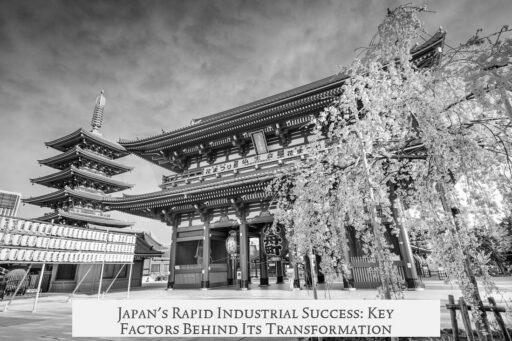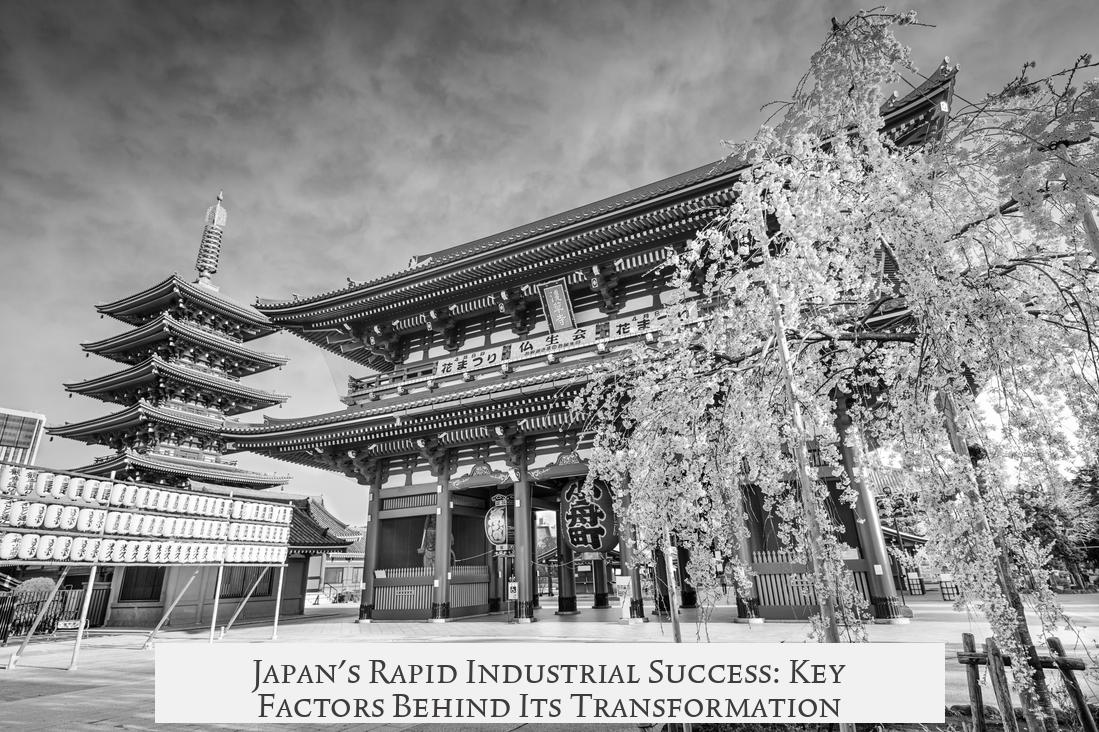Japan industrializes quickly and successfully due to a combination of pre-existing economic shifts, strong state intervention, strategic adaptation of foreign technology, social restructuring, imperial expansion, and post-war recovery efforts.
Japan’s industrialization roots stretch back before the Meiji Restoration of 1868. In the 18th and early 19th centuries, Japan faced economic strain as silver—the key trade commodity—became scarce. This crisis pushed the Tokugawa shogunate to restrict imports and foster local manufacturing through workshops near castle towns. This grassroots growth sparked an industrious revolution that laid groundwork for later industrial developments.
Japan’s relatively small size and political instability distinguished it from Qing China, which remained more stable and less motivated to reform. The strain on the samurai class caused social unrest, culminating in the overthrow of the Tokugawa regime. This upheaval provided a unique chance to reshape Japan’s social and economic structures rapidly. Additionally, Japan observed China’s military defeat by western powers and understood the dangers of resisting modernization. This knowledge empowered pro-Western factions to push for industrial and military reforms.
Western powers showed limited direct interest in Japan during this initial period compared to their engagements elsewhere. This lack of immediate foreign threat allowed Japan to focus on internal reforms without the distractions of colonization or continuous conflict. Furthermore, Japan’s industrialization lag was minimal compared to leading nations, making it feasible to adopt existing models rather than inventing new ones from scratch.
Central to Japan’s rapid industrial advance was strong state leadership committed to modernization. The Meiji government actively studied Western political systems and technologies, sending missions abroad and inviting foreign experts to Japan. Their slogans—“rich country, strong military” and “civilization and enlightenment”—guided aggressive state involvement in economic planning and industrial organization.
Japan structured its industrial economy around zaibatsu, large family-controlled conglomerates that vertically integrated supply chains. These combines eliminated inefficiencies and collaborated closely with the government. This partnership extended into labor, where the state harnessed a large workforce. Young women, particularly from poor families, became vital in light industries such as textiles. While wages were low by global standards, factory work often offered better conditions than alternatives like prostitution. This female labor force enabled mass production of goods like silk, crucial for export and capital accumulation.
The Japanese approach relied heavily on importing and adapting foreign industrial blueprints. Factories were copied and reverse-engineered, minimizing the need for highly skilled labor and cutting the development period. This method focused on simple, semi-skilled tasks, enhancing rapid scale-up.
Imperial expansion also influenced industrial growth. Japan imposed unequal treaties on Korea and expanded through wars with China and Russia. Colonies offered new markets and raw materials, which fueled further industrialization. Japan’s participation in World War I as an ally allowed it to seize German colonial territories and gain access to additional resources and markets, avoiding combat losses and boosting exports.
During the 1930s, Japan pursued economic self-sufficiency, preparing for total war by controlling key industries and raw materials. This led to further territorial conquest and a centrally controlled industrial sector. The oil embargo imposed by the United States provoked Japan’s attack on Pearl Harbor and subsequent seizures of Southeast Asian assets to secure vital resources for military and industrial needs.
After World War II, despite much destruction, Japan retained a skilled workforce and industrial expertise. The U.S. occupation initially targeted zaibatsu dismantling but reversed policies due to Cold War concerns. The Korean War provided a critical economic stimulus as American military spending flowed through Japanese industry. The Ministry of International Trade and Industry (MITI) coordinated industrial policy, guiding keiretsu—successors to zaibatsu—to cooperate and avoid internal competition.
Labor relations in the post-war era fostered collaboration. Enterprise unions agreed to company loyalty and lifetime employment in exchange for job security and promotion. This corporatist system supported stable industrial growth and productivity improvements, enabling Japan’s export-led economic boom.
Japan’s trade surplus grew from demand for unique Japanese products like kimonos, providing capital for investment. The country’s ongoing trade relationships, including with the Dutch and neighboring states, meant Japan was never economically isolated. Also, utilizing already developed industrial technologies shortened the timeline for industrialization. Despite its mountainous terrain and a large rural population well into the 20th century, Japan mechanized efficiently in key sectors concentrated in urban centers and coastal areas.
- Japan’s early economic shifts and social unrest set the stage for rapid reform.
- Strong government planning facilitated adoption of Western technology and industry.
- Zaibatsu and labor strategies maximized production and efficiency.
- Expansionist policies secured resources and markets to fuel growth.
- Post-war recovery leveraged U.S. support and coordinated industrial policy.
How Did Japan Industrialize So Quickly and So Successfully?
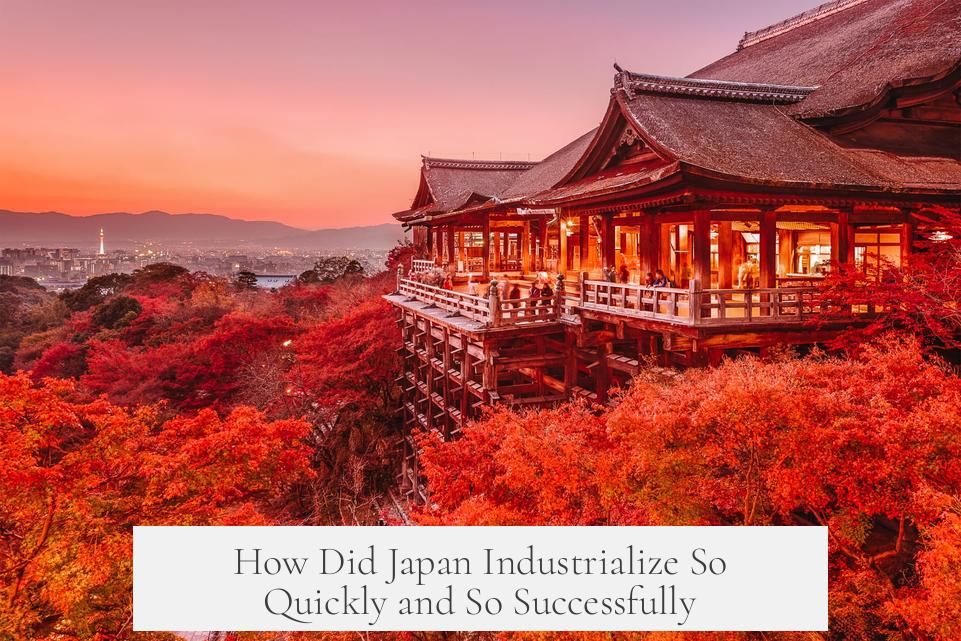
Japan’s rapid industrialization is the result of a unique set of historical circumstances, smart state-led policies, social reform, and strategic international maneuvering. It wasn’t magic or just luck—Japan leveraged existing foundations, learned from other nations, and shaped its own path with remarkable determination.
Let’s unpack how this island nation transformed from a feudal society into a global industrial powerhouse in just a few decades.
Setting the Stage: Early Foundations Before the Industrial Boom
Industrial revolutions don’t pop out of thin air. Japan’s journey begins with the industrious revolution of the 18th and early 19th centuries. Facing dwindling silver reserves crucial for trading luxury goods like silk with China, the Tokugawa shogunate tightened trade restrictions. This spurred localized workshops in castle towns’ outskirts, encouraging import substitution—basically, making stuff at home rather than relying on imports.
These early efforts planted seeds of an industrial mindset. People learned to hustle, innovate, and produce locally. It wasn’t full-blown industrialization yet, but a practice run that helped later.
Compared to its giant neighbor Qing China, Japan’s smaller size turned out to be a blessing. Implementing sweeping reforms after the Meiji restoration was easier here. Meanwhile, the rigid Tokugawa social order was cracking. Many samurai were poor, merchants were wealthy—an imbalance that caused unrest and paved the way for revolutionary change in 1868.
“Japan’s compact size and internal tensions primed it for fast reforms.”
Watching from the Sidelines: Learning from China’s Missteps
Japan didn’t just stumble into change blindly. It keenly observed China’s painful defeat in the Opium Wars against Britain. This stark example showed the tomorrows awaiting Asian nations that ignored Western industrial and military advancements.
Japan’s reformists argued, “Better to adapt western technology and systems than resist and perish.” Their vision won out, unlike in China. This willingness to learn helped Japan leapfrog into modernization.
Interestingly, Western powers weren’t scrambling to colonize Japan. They mostly saw it as a pit stop, not a prize. This fortunate lack of imperial pressure gave Japan space and time to reshape itself without massive interference.
And contrary to some ideas, Japan wasn’t outrageously late to industrialize—only about 10-20 years behind Germany and 30-40 years behind the US. With blueprints and lessons already available, they could jump ahead quickly.
The Meiji Government: Driving State-Led Industrialization
The new Meiji leaders rolled up their sleeves. Under banners like “rich country, strong military” and “civilization and enlightenment,” they prioritized importing Western political ideas, technology, and know-how.
They sent missions abroad, brought experts to Japan, and directly invested in industries. It was classic top-down, state-led transformation. This wasn’t laissez-faire capitalism by any means. The government was hands-on, steering the economic ship firmly.
And they smartly sought public backing by promising more inclusive deliberative councils, even if genuine representation was limited at first. Resistance existed, especially around conscription, but overall, the reform momentum held strong.
Mobilizing Japan’s Workforce: The Secret Role of Women
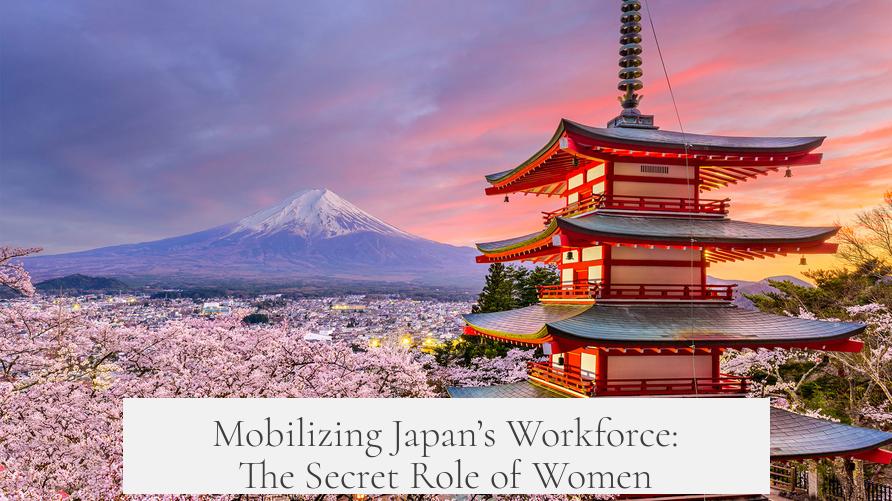
One of Japan’s industrialization engines was an often-overlooked source: young women. Especially in textile industries like silk, impoverished girls were enrolled in factory contracts. Though wages were low by global standards, factory work offered food, shelter, and a step up from poverty or worse alternatives.
In fact, when authorities tried to clean up red-light districts, some former prostitutes and geishas were trained in textile skills, feeding the labor supply. Women were viewed as ideal workers for detailed factory tasks—an early form of labor specialization.
This flexible, vast labor force helped sustain light industries crucial for export and domestic development.
Import and Adapt: Reverse Engineering Industrial Success
Japan didn’t reinvent the industrial wheel. Instead, it imported whole factory blueprints, machinery, and job methods from the West. They faithfully copied, reverse-engineered, and sometimes improved on them.
The industrial model required mainly low-skilled workers performing specialized, repetitive tasks. This approach avoided the need to train large numbers of highly skilled artisans, expediting factory setup and production.
Further boosting efficiency, Japanese industries formed zaibatsu—large, vertically integrated conglomerates controlling entire supply chains. These combines reduced waste and worked closely with the government to meet national goals.
Empire and Expansion: Fuel for Industrial Growth
Japan wasn’t content with internal growth only. Early imperialism played a key role. Just eight years post-Meiji, Japan forced Korea to open markets with the Treaty of Kanghwa in 1876. This move gave Japan access to new customers and cheap raw materials.
Wars further boosted industrial capacity. Victories in the Sino-Japanese (1894-95) and Russo-Japanese (1904-05) wars, plus the annexation of Korea in 1910, secured territorial gains fueling industrial raw material needs.
World War I was a golden opportunity. Japan joined the Allies and took over German Pacific colonies. Since it avoided destructive fighting at home, Japan’s factories filled the void left by war-torn European manufacturers on global markets.
Result? Japan generated trade surpluses and cemented its status as a major power—without getting its factories bombed.
Pursuit of Economic Self-Sufficiency and Central Planning
By the 1920s-30s, Japan realized military strength alone wasn’t enough. Economic security mattered, especially when facing the global depression and rising tensions. Inspired by Germany’s example in WWI, Japan pursued autarky.
This push led to more expansion, such as the creation of the Manchukuo puppet state. The economic reformers and military expansionists joined forces, passing laws favoring centralized industry control and war materiel production.
Of course, this era brought conflict, including a US oil embargo in response to Japan’s aggression. Japan retaliated with surprise military strikes (Pearl Harbor) and seized European colonial holdings for vital resources like oil and rubber.
Post-War Reconstruction: Rising from the Ashes
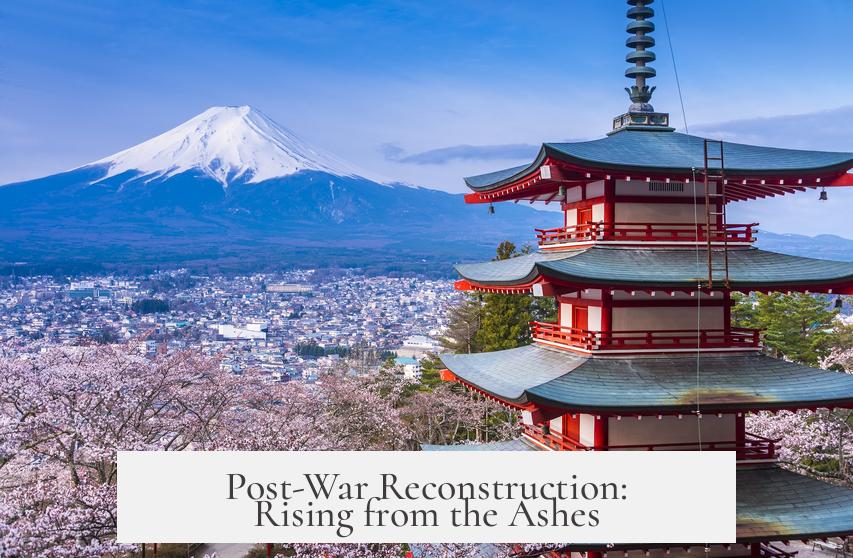
World War II devastated much of Japan’s industrial infrastructure. Still, the skilled workforce and basic know-how survived. Importantly, the US occupation initially aimed to dismantle Japan’s industrial giants, the zaibatsu.
However, growing Cold War fears changed the game. The US shifted to rebuild Japan’s capitalist economy to counter communism instead of democratizing completely. This “reverse course” preserved industrial capacity but under new terms.
The Korean War was a huge boost. American military procurement flowed through Japan, injecting money and demand into heavy industry, accelerating recovery.
Japan’s Ministry of International Trade and Industry (MITI) expertly guided economic policy. The former zaibatsu were restructured into horizontally integrated keiretsu, which avoided self-destructive competition and maximized overall growth.
Labor relations also evolved. Enterprise-based unions traded lifetime employment and seniority in exchange for cooperation, fostering company loyalty and productivity, key to Japan’s high-growth years.
Additional Nuances That Made a Difference
- Japan had a surprising asset: its exotic cultural goods, especially kimonos. Western middle classes craved these, creating trade surpluses that pumped capital into industrial investments.
- Despite isolation myths, Japan wasn’t closed economically—the Dutch and neighbors maintained trade ties, preserving some international exchange and knowledge flow.
- Borrowing existing industrial blueprints saved Japan years of costly research and development, accelerating its path to industrialization.
- Geography posed challenges—Japan’s mountainous terrain made mechanizing agriculture hard. As a result, rural populations remained large well into the 1970s, affecting industrial labor dynamics.
A Recap: Why Japan’s Industrial Revolution Stands Out
Japan’s industrial miracle isn’t a single-factor story. It’s a complex dance of:
- Strong pre-industrial economic foundations spurred by necessity and innovation
- Political upheaval that replaced old elites with reform-minded leaders
- Strategic learning from other nations, including the cautionary tale of China
- Effective state-led planning and technology importation
- Mobilization of a flexible workforce, especially women in textiles
- Imperial expansion providing raw materials and markets
- Post-war recovery aided by US geopolitical strategy and centralized economic coordination
- A blend of cultural exports creating vital trade surpluses
Each piece fit beautifully into a broader puzzle, enabling Japan not just to catch up but to thrive industrially in a tight timeline.
Food for Thought:
What lessons might other developing countries glean from Japan’s path? Could smart state intervention and learning from others still fast-track industrialization today? Or has the world changed too much for that model to repeat?
At the very least, Japan’s story reminds us that rapid transformation is possible when necessity, vision, and willpower align.
